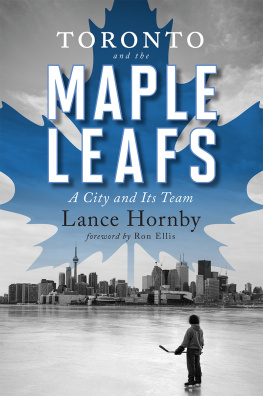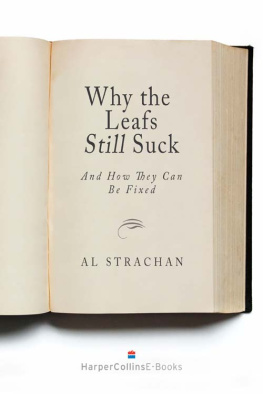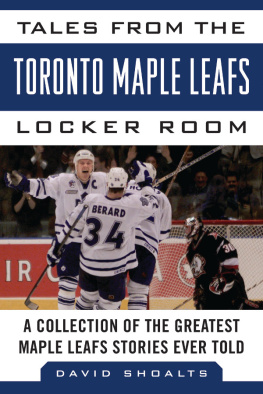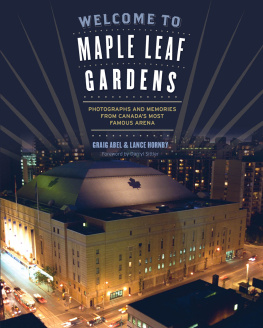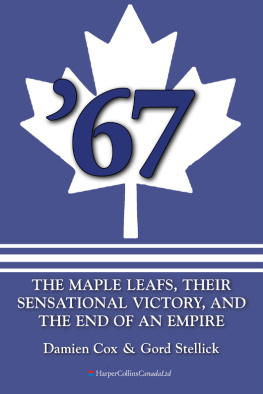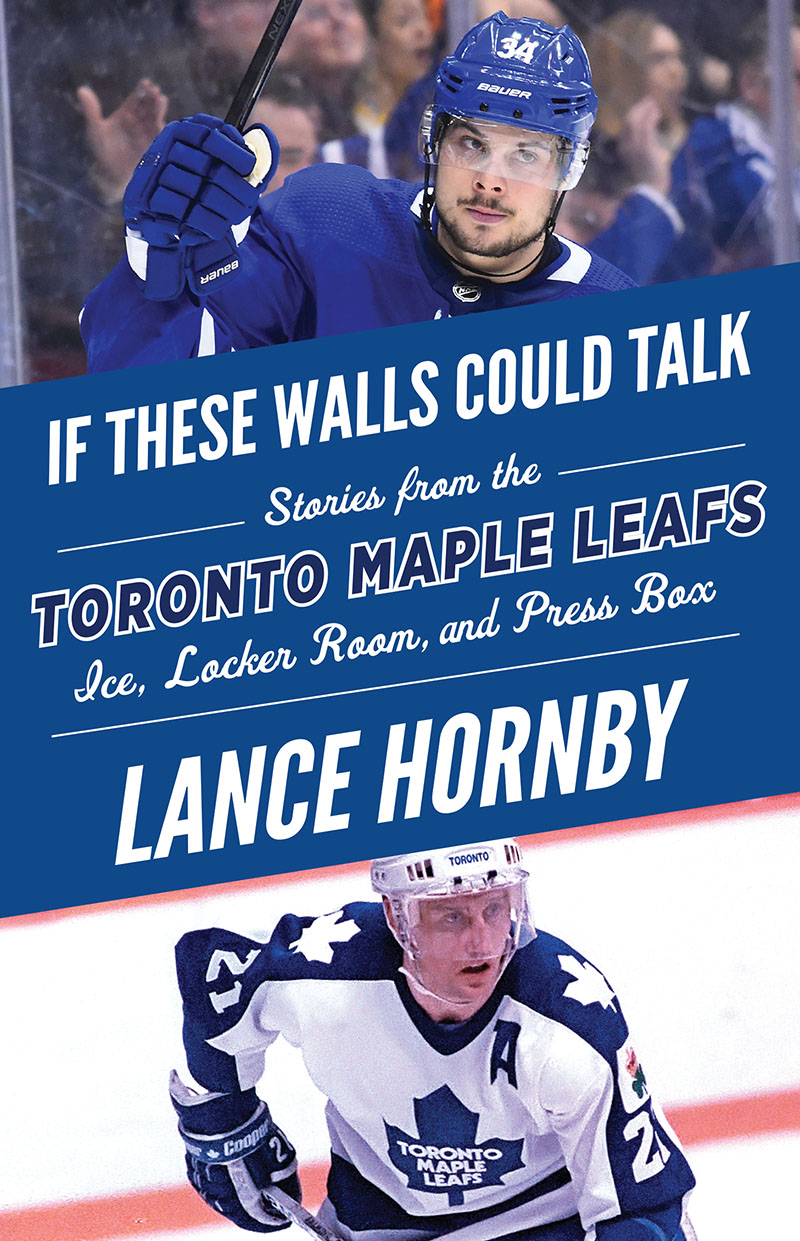
To my fellow writers and broadcasters on the Leafs beat of past, present, and future. Keep those stories coming.
Contents
Forword by Mark Osborne
Playing Saturday on Hockey Night in Canada is still the ultimate high for an NHLer. Its even better when you play for the Toronto Maple Leafs. From the instant you wake up that morning, the buzz in the city is palpable. In my era of the 1980s and 90s, by the time you arrived at Maple Leaf Gardens, the atmosphere was unbelievableno matter how the Leafs were doing or what team was in town. Its still that way at Scotiabank Arena.
When I played minor hockey in the city or as a member of the Niagara Falls Flyers facing the junior Marlies in the afternoon, wed come to the Gardens early to soak it all in as we watched the Leafs skate in the morning.
The first time I was traded to the Leafsfrom the New York Rangers in March 1987it was a dream come true, but it was also a shocker. Wed played the night before, and Id had a good game. So when our general manager in New York, Phil Esposito, phoned that morning, I actually thought he might be calling to compliment me. Little did I know, Id be coming home.
Gord Stellick, later to be my co-host on Leafs radio postgame shows, was the Toronto assistant general manager at the time. He remembers the deal, too. My father had passed away four or five months earlier. My mom was now alone and moving back to Toronto from Vancouver, so it was a nice gesture by both teams to work something out for me to be closer to her.
My first thought before everything sunk in was: Wow, this is the team I grew up watching. Right away, it all came back: Hockey Night , the sights and smells, the subway rides from the west end with Dad, the College Station stop, the walk down Carlton Street with all the fansand all the scalpers. I remembered the scent of the popcorn and the chestnuts in the hallways, the ushers with their white hats, and how the bright lights from above accentuated the vivid colours of the seats and playing surface as you emerged from the tunnel and gazed toward the ice. Now I was walking in that same building as a Leaf.
When I took that first step inside the dressing room, all I could think of was how proud my dad wouldve been and that I wished he could see me play there as a Leaf. There was a sweater hanging with Osborne on the back. Id been traded for Jeff Jackson, so they gave me his No. 12 and just switched the nameplate. Id already played for two Original Six teams, having been drafted by the Detroit Red Wings, so I considered myself very fortunate to make it three, including my hometown team. But I didnt have a lot of time for nervesnot at 4:30 pm on a gameday.
I dont know if someone can ever be prepared to play for the Leafs. Unlike in Detroit and New York, in Toronto you sense that people know you when you walk around the streets. But you also come to realize what the Leafs were all about for so many decades. They were Canadian boys who did not take that adulation for granted.
At the time I arrived, things hadnt been going too well. There were even draft prospects whod said they didnt want to play in Toronto. But Wendel Clark had been picked first overall a couple of years earlier and he was changing the views of a lot of people. We played the Pittsburgh Penguins that first game, and it was a great start for me. They had Mario Lemieux, but we played really well and won 72. I had a goal, and it was assisted by Russ Courtnall and Todd Gill, who was still with the team when I came back to Toronto a second time in the 1992 trade with the Winnipeg Jets for Lucien DeBlois.
The dressing room is where a team truly grows and the great stories begin. I had the good fortune the first time that coach John Brophy played me with Gary Leeman and Ed Olczyk. The writers called us the GEM line, combining the first initials of our first names, though those two were really the gems, and I was the scuffed-up marble. We had a measure of balance. We were 1-2-3 in team scoring in 8788, and Leeman scored 50 a couple of years later.
But it was more than just hockey with us because we became close friends off the ice.
Olczyk and Leeman got into horse racing as part owners, and I tagged along. Olczyk and I both got married the same year in 1988. Sure, I was disappointed to be traded in 1990, but at least I went with Olczyk to Winnipeg, and we had a lot of tales about that place, too.
They say timing is everything, and that was certainly the case when I was dealt back to the Leafs two years later. The team was about to turn the corner, even though few players, fans, and media realized it. Pat Burns came in as coach a couple of months after I returned, and we suddenly had that respectability everyone had waited so long for. It was a lot like whats happening with todays Leafs.
Burnsie put me on a line with centre Peter Zezel and fellow winger Bill Berg, and we checked hard, hit hard, and scored a bit. I really enjoyed that role. It became even more special to me that the team as a whole did well, and we almost made it to the Stanley Cup Final in 93.
To have experienced the desolation of the Harold Ballard era when I first arrived, to watching people celebrating and closing down the streets to traffic, that was crazy. I have some great memories and pictures from that time. My wife, Madolyn, and my kids, Abigail and Eliza, tease me that that Im still riding those stories today. And Im sure Ill keep telling and re-telling them for years to come. You dont forget anything about being a member of the Toronto Maple Leafs.
Mark Osborne
Maple Leafs left wing 198694
Introduction
Hey, you hang around the Maple Leafs? Must have a few good stories, eh?
Those of us on the beat hear that all the time from fans; while at dinner with friends; via the mailman, the store clerk, or an out-of-town writer curious about Canadas most scrutinized hockey team. I can only reply, Sure, I have some. How much time do you have?
Its an intoxicating topic. Once you spin one colourful blue-and-white yarn, you think of another and another with the audience wanting an encore. Often they add their own experiences at the Gardens, involving friends, parents, or grandparents. Maybe they hate the Leafs and have a good tale about a rival getting the last word. For better or worse, to grow up in Toronto is to grow up with the Leafs.
With the Leafs having gone more than 50 years without a titlea challenge fellow authors of the Montreal Canadiens, Dallas Cowboys, and St. Louis Cardinals in the If These Walls Could Talk series didnt face, by the waywriting this book meant digging into a trove of older stories from the back files. Thats the fun part, as the century-old Toronto franchise is often equal parts history, honour, humour, and human error. Yes, even in championship seasons13 Stanley Cups from their inception as the Toronto Arenas to their final four in the 1960sthere were still plenty of rough patches. Conversely, their darkest hours produced many light moments.
More than 900 players have suited up for the franchise since 1917, and through many winters, their stories have come to light: a three-team NHL, the construction of the Gardens during the Great Depression, the war years when hockey was a diversion, the good men, the bad apples, the triumphs, and troubled times.
My generation grew up when the Leafs ruled the city. They were on TV every Saturday night before the Blue Jays, Raptors, and Fortnite . Though the players were sometimes snowy specs on a tiny black-and-white screen, they seemed larger than life. And the Gardens looked so small from my living room yet so immense when I blinked into its bright lights on my first visit.


